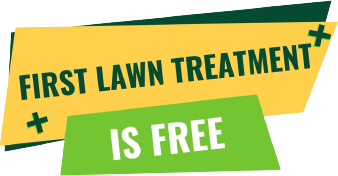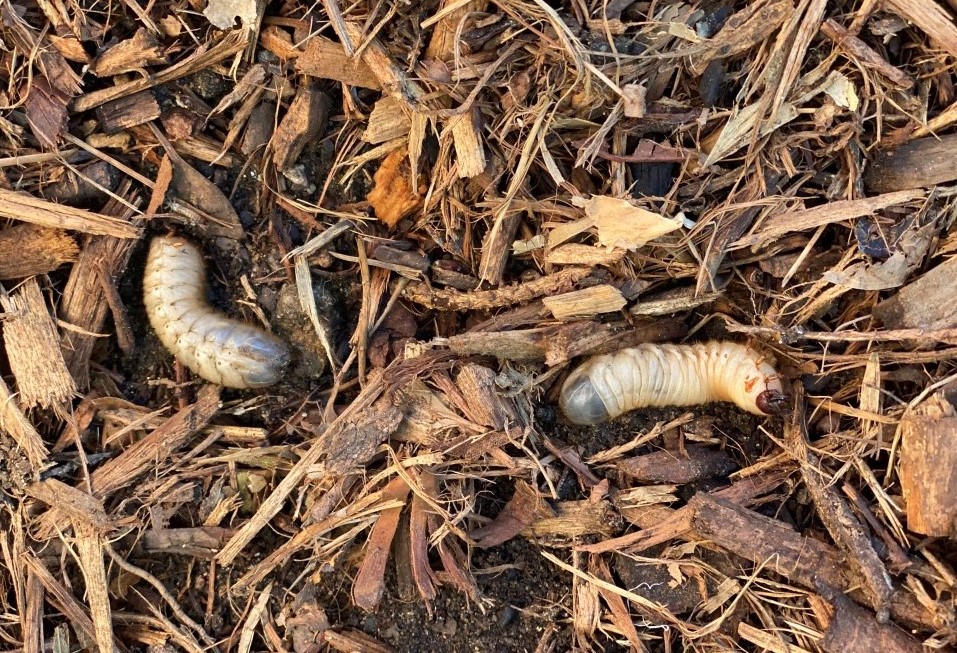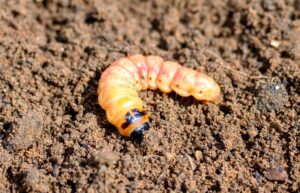During the summer, lawn grubs, which are the larvae of beetles, are large and therefore can be easily spotted in your lawn. Also, if you notice a lot of beetles flying in early summer with dead patches of grass appearing in late summer, chances are you have grubs in your lawn.
Springtime monitoring is essential to give you an idea of the population number of grubs on your property and to take appropriate control measures if you want to avoid an infestation.
When checking for grubs, it’s best to use a shovel and dig up a few small holes in the parts of the lawn where you suspect they might be hiding. These chubby white worms will usually lay in a C-shape when you expose them.
A grub infestation can be very destructive to your lawn as these pests feed on the roots of the grass, plants, and other organic matter in the soil.
Keep reading to find out more about grubs and how you can prevent and control them.
What Are Grubs And Where Do They Come From?
Grubs are the larvae, in other words, the immature stage of many species of beetles, including the Japanese beetles, Oriental beetles, chafers, May beetles, June bugs, and billbugs.
They measure between a quarter to over an inch in length. They are off-white and wrinkly, have brown heads and soft bodies with three pairs of legs near the head.
Around November, the grubs tunnel deep in the ground and turn into pupae in preparation for the winter resting stage. After the hibernation period is over, the eggs hatch and the larvae start burrowing around and eating the plant roots. Because the larvae burrow deep, it’s usually not possible to see them with your own eyes unless you start digging into the grass. Eventually, the white immature creature will turn into the adult beetle form and come out of the soil to mate and lay eggs on the surface in June and July.
The grubs are attracted to thick, lush, and healthy grass. This indicates that the grass has a healthy root system, and this is why the grubs consume the roots as soon as they hatch.
Keep in mind that excessive use of chemicals on your lawn can also affect healthy grass growth, and a stressed lawn is more susceptible to pest infestation and disease. Overusing chemicals will harm the natural beneficial insects living in the ground. This, in turn, will cause the population of harmful pests like grubs to rise. And the larger the population of worm larvae, the more severe your lawn damage is going to be.
What Do Grubs Do To Your Lawn?
As grubs feed on the roots of all types of vegetation, they are most definitely not good for your lawn. These pests can cause irreparable damage to grass and all sorts of plants in your garden. They will destroy the lawn because their feeding on the grass roots and soil organic matter will cause sections of the grass to die.
The grub damage is greatest in mid to late summer, when you notice areas of your lawn starting to thin and turn yellow. At a later stage, larger irregular brown patches will appear in the turf, gradually increasing in size. Often, grass that’s damaged by grubs will pull out at the roots very easily. From late summer until mid-fall, grubs increase their food intake, and the damaged or dead grass becomes even more visible.
Typically, grub worm problems tend to develop in lawns with only one species of grass, or lawns that are often over-irrigated or over-fertilized. When populations of more than 15 grubs per square foot of turf are present, your lawn can develop brown patches that peel back as easily as a carpet.
Pay attention if you have wildlife such as moles, raccoons, skunks, or birds digging around your lawn, as this could be a sign of grub infestation. Another way to find out if you have a grub infestation is to step onto the turf in springtime and check if it feels bouncy or spongy.
How To Control Grubs In Lawn?
The solution to grub control is to eradicate these worms before they start to hatch and cause damage to your lawn.
Grub control measures should be taken each year to ensure that they are consistent and effective. You may skip one year, however, bear in mind that if some beetles have laid their eggs in the soil of your lawn in the last year, you will most likely be facing a seriously damaged lawn by around October.
Ideally, it’s recommended to apply grub control products twice in a season in most cases.
The best time for grub control measures is between early spring and late summer, as at these times there is an increased grub activity in the lawn.
The most effective way to kill grubs is to use chemical insecticides. As soon as you notice any sign of infestation in the spring, apply an insecticide that is a grub killer. You might treat your lawn with carbaryl or trichlorfon, which are short-lived compounds that kill grubs at all life stages. You should use these chemicals if there are high numbers of grubs found in your grass in the fall and in spring before early May.
Other effective control products against grubs include clothianidin, imidacloprid, and thiamethoxam, but they only work if applied in June and July.
Next, a preventative grub control product needs to be applied around June and July in order to stop their development cycle. This is particularly important if you’ve already had issues with grubs in the past.
Besides the chemical products, there are also natural methods to take advantage of, if you want to get rid of grubs in your lawn. Some of them include:
– Encouraging birds to visit your yard on a regular basis.
– Limiting lawn irrigation.
– Treatment with milky spore in summer and early fall. The milky spore is a bacterium that’s used to control Japanese beetle grubs.
– Feeding the worms to your chickens.
– Spraying your lawn with earth-friendly beneficial nematodes. The nematodes, also called roundworms, will multiply over time and feed on grubs and other soil-inhabiting insects.
– Applying neem oil, which acts as a repellant against grubs and contains insecticidal properties. Neem oil inhibits egg-laying, feeding, and the growth of grubs.
Is your lawn under attack by grubs?
If you feel that you’ve failed to achieve the results you’d wish for, call us today to see how we can help you get rid of your grub problem in no time.
Guaranteed Green provides a professional lawn insect and perimeter pest control program for Metro Atlanta residents. We can control most seasonal invasive pests, including grubs. We are ready to wipe them out for good!
Prohormones are mainly used for muscle mass building.




